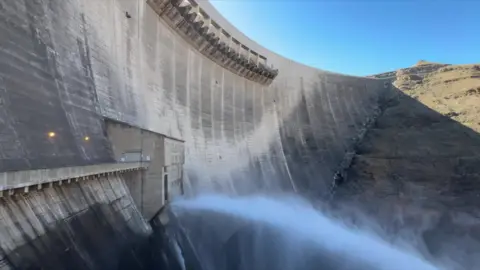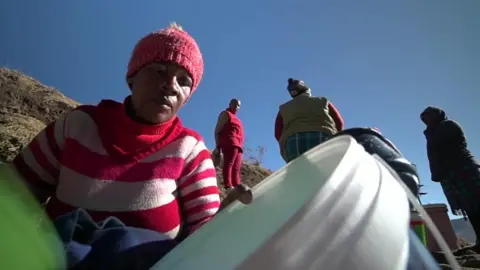 BBC
BBCHere in Lesotho, water is often referred to as white gold due to its significant role in the country’s economy.
The Katse dam, a towering engineering marvel at 185m tall, stands as Africa’s second-largest curved dam, part of the Lesotho Highlands Water Project.
Lesotho’s unique geography, as the only country entirely above 1,000m, provides it with abundant precipitation, allowing it to supply water to neighbouring South Africa via Katse.
Water Scarcity in Ha Ramokoatsi Village
Despite the proximity to the dam, Ha Ramokoatsi village’s residents, like Manteboheleng Mosiyoa, continue to suffer from water scarcity, relying on a contaminated spring for their daily needs.
The health implications of consuming this water are evident, with residents experiencing various illnesses due to the poor quality of water available.

Ms Mosiyoa’s experience highlights the disparity between the economic gains from the dam and the lack of accessibility to clean water for local communities.
Government’s Role and Future Initiatives
Despite the economic benefits to Lesotho, the government acknowledges the need to prioritize water provision for local communities by 2030.
As water demand rises, especially from regions like Gauteng, South Africa, sustainable management and infrastructure improvements are crucial to ensure equitable distribution.
The complex dynamics of water supply and demand in the region exemplify the challenges faced by developing countries in harnessing natural resources while ensuring social welfare.
Importance of Infrastructure Development
Professor Anja du Plessis emphasizes the necessity of investing in infrastructure to address water loss and ensure sustainable water supply for all.
The international agreements for water transfer further underscore the interdependence of nations in managing water resources responsibly.
More BBC stories on Lesotho:
 Getty Images/BBC
Getty Images/BBC BBC
BBCHere in Lesotho, water is often referred to as white gold due to its significant role in the country’s economy.
The Katse dam, a towering engineering marvel at 185m tall, stands as Africa’s second-largest curved dam, part of the Lesotho Highlands Water Project.
Lesotho’s unique geography, as the only country entirely above 1,000m, provides it with abundant precipitation, allowing it to supply water to neighbouring South Africa via Katse.
Water Scarcity in Ha Ramokoatsi Village
Despite the proximity to the dam, Ha Ramokoatsi village’s residents, like Manteboheleng Mosiyoa, continue to suffer from water scarcity, relying on a contaminated spring for their daily needs.
The health implications of consuming this water are evident, with residents experiencing various illnesses due to the poor quality of water available.

Ms Mosiyoa’s experience highlights the disparity between the economic gains from the dam and the lack of accessibility to clean water for local communities.
Government’s Role and Future Initiatives
Despite the economic benefits to Lesotho, the government acknowledges the need to prioritize water provision for local communities by 2030.
As water demand rises, especially from regions like Gauteng, South Africa, sustainable management and infrastructure improvements are crucial to ensure equitable distribution.
The complex dynamics of water supply and demand in the region exemplify the challenges faced by developing countries in harnessing natural resources while ensuring social welfare.
Importance of Infrastructure Development
Professor Anja du Plessis emphasizes the necessity of investing in infrastructure to address water loss and ensure sustainable water supply for all.
The international agreements for water transfer further underscore the interdependence of nations in managing water resources responsibly.
More BBC stories on Lesotho:
 Getty Images/BBC
Getty Images/BBC











